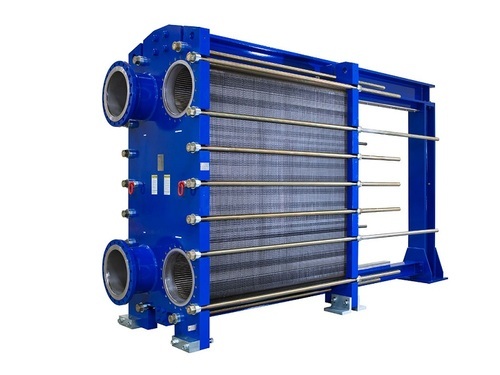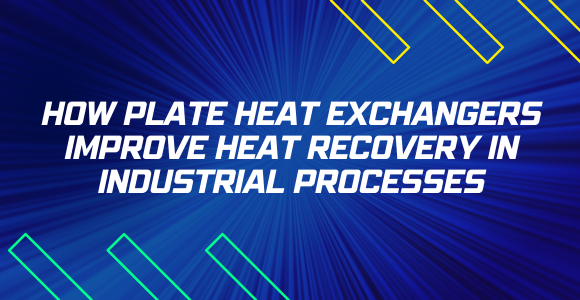Recovery of heat is an integral part of energy optimization in industrial processes. Businesses may reduce their energy costs and impact on the environment by capturing and reusing waste heat. One of the efficient tools used in recovering heat is a plate heat exchanger. In this blog, we discuss how plate heat exchangers enhance the heat recovery processes in industries and help them function in a more efficient way.
What are Plate Heat Exchangers?
A plate heat exchanger is a kind of heat exchanger that uses thin metal plates to transfer heat across two types of fluids. A wide surface area created by the arrangement of these plates parallel to one another enables effective heat exchange. Heat transfers from one fluid to another without ever mixing as hot and cool fluids move through different paths.
This feature enables PHEs to be among the most effective heat exchangers for recovering and reusing waste heat in industries such as chemical, pharmaceutical, and food processing.

How Plate Heat Exchangers Improve Heat Recovery
The recovery of heat requires effective heat transfer, which plate heat exchangers constantly provide. Through the utilization of PHEs, companies can recover a significant amount of waste heat from one process and use it for another, saving extra energy costs.
Here are a few ways plate heat exchangers contribute to better heat recovery:
High heat transfer efficiency
The thin plates in PHEs allow for maximum heat transfer to take place with the least material, making them much more efficient compared to other conventional heat exchangers.
Compact Design
These heat exchangers are compact and lighter compared to other heat exchangers. This means they occupy less space and can even be installed at any industrial facility with much more ease.
Reduced Energy Consumption
Capturing and reusing heat reduces energy usage for any business, saving large amounts of money and lowering carbon emissions.
Benefits of Using Plate Heat Exchangers for Heat Recovery
PHEs are used in a number of industrial processes, with their application being advantageous in more ways than just the singular aspect of recovering heat. Some of the advantages include:
Energy Savings
One of the primary benefits of PHEs is their ability to reduce the cost of energy. Through heat recycling, businesses can lessen their dependency on outside energy sources.
Lower Use of Resources, Lower Environmental Impact
Using less energy lowers greenhouse gas emissions. Plate heat exchangers (PHEs) help achieve this by improving energy efficiency in industrial processes. By recovering and reusing waste heat, PHEs reduce the need for additional resources, leading to a lower environmental impact and supporting more sustainable industrial practices.
Improved efficiency in processes
The recovered heat allows for smoother industrial operations with less downtime, which not only helps increase productivity levels but also optimizes resource use and enhances overall operational effectiveness.
Flexibility and Scalability
Plate heat exchangers can also be tailored according to the demands of an industry. It makes them adaptable to various processes and easy to scale up whenever operations grow.
Industries Benefited by Plate Heat Exchangers
The versatile efficiency of plate heat exchangers can be applied to several industries. The following are some of the industries that can benefit the most from plate heat exchangers:
Chemical Industry
The requirement for precise temperature control through cooling and heating is quite prevalent in the manufacturing of chemicals, and therefore, PHEs have been widely employed in this field.
Food and Beverage Industry
PHEs are widely used for processes like pasteurization, fermentation, and cooling in the food and beverage industry. They help maintain product quality while improving energy efficiency, which is crucial in this sector.
Pharmaceutical Industry
Maintaining specific temperatures is critical in pharmaceutical manufacturing to ensure product integrity and safety. PHEs are effective in managing these temperature requirements and can contribute to energy-saving initiatives by improving the efficiency of heating and cooling processes.
Conclusion
The plate heat exchanger contributes to solving various industrial problems through its potential for improving heat recovery. Evidently, the efficiency with which PHE transfers heat between fluids provides businesses with ways to consume less energy, save money, and meet their goals of sustainability. From chemicals and pharmaceuticals to food and processes, it has been proved that PHEs can provide appropriate and advanced levels of efficiency in recovering heat.
We at Pragya Associates have been offering nothing but the best plate heat exchangers for clients all over the globe, along with other heat transfer-related solutions, to help them enhance productivity and stay competitive in today’s fast-paced industrial world.







